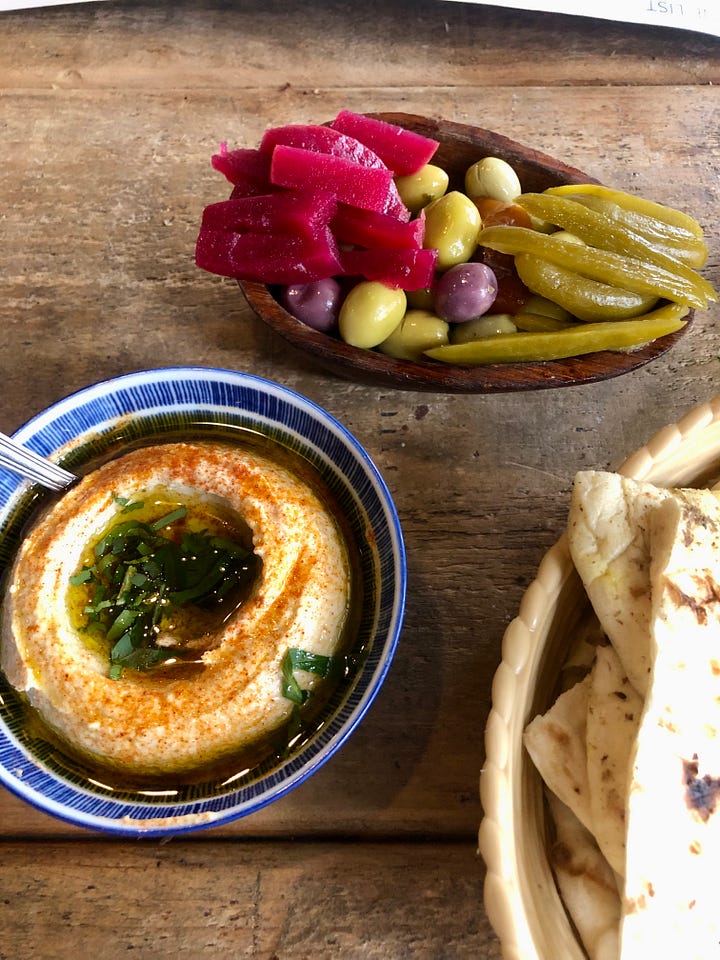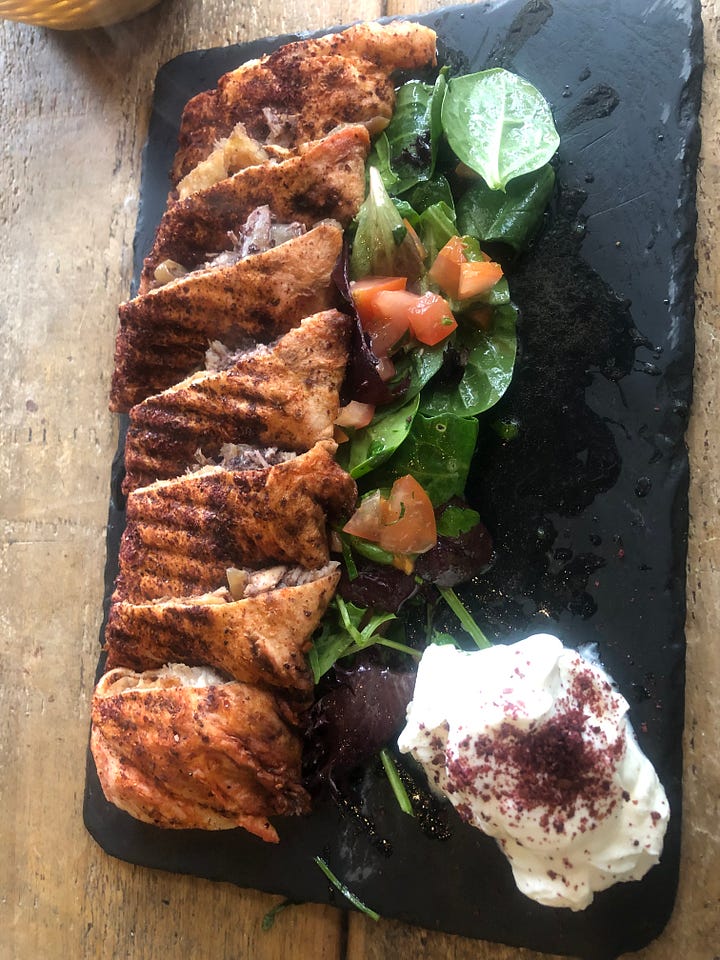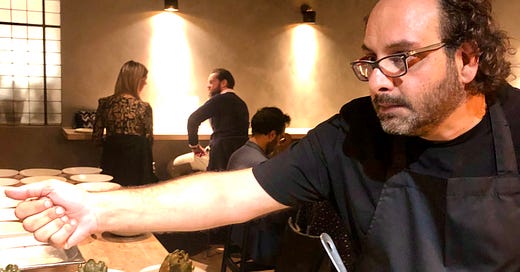Palestine's feast - and hunger in time of war
Gaza is suffering this Eid, but the joy of sharing Palestinian cuisine remains. Plus: what I've been drinking this week




THE Muslim feast of Eid al-Fitr today, marking the end of Ramadan, will be tinged with sadness for Palestinians but especially for those in the Gaza strip. Following Hamas’s attacks on Israel on 7 October last year, killing over 1,000 people, Israel’s invasion of Gaza is estimated to have killed more than 33,000 Palestinians and reduced most of the area to a wasteland. With the UN warning of famine in the enclave from next month, few Gazans will have the means to celebrate what would normally be a family feast akin to an extended Christmas dinner.
Palestinian food is all about enjoying hospitality together around a tawla, a dining table laden with sharing plates. It’s becoming better known in UK, and not just from the growing ubiquity of falafel and shawarma. Palestinian chef Fadi Kattan, based in Bethlehem, opened his stunning Notting Hill restaurant Akub in early 2023. The irony during the Gaza crisis, as Kattan told website London On The Inside earlier this year, is that “every single product we’re using here, there are two million people that are being denied access to it… It makes our responsibility much bigger.”
British-Palestinian chef and author Sami Tamimi, erstwhile collaborator with Israeli-born Yotam Ottolenghi, has been vocal in his support for Gazans and in condemnation of the war, publicising the #CookForPalestine humanitarian fundraising campaign. And he has introduced Brits to his homeland’s cuisine, both through his work with Ottolenghi and his own inspirational cookbook, Falastin (2020).
What precisely constitutes Palestinian food – as opposed to how it should be enjoyed – is harder to pin down. There is agreement on the most uniquely local dish: musakhan – roasted chicken served in layers of flatbread with lots of caramelised onion and sumac. Likewise I have not seen maftoul, a giant couscous made from bulgur and wheat flour and served with chicken or vegetables, in other cuisines.
Many other Palestinian favourites, however, are prepared more widely. Maqlubeh, the unusual upside-down dish of rice with meat and vegetables, cooked in a pot before being turned out on a big platter, is also eaten in Jordan, as is mansaf, lamb cooked with yoghurt. The pea stew bazella, available as an advance order for a feast at the brilliant Café Maramia in West London, London’s only all-Palestinian restaurant aside from Akub, is also enjoyed in Lebanon. So of course is hummus. But there are large Palestinian refugee populations in Lebanon and Jordan, further muddling the food’s origins.
And while the staff at small London shawarma chain Hiba proudly sport Palestinian keffiyehs and flags, you’d be hard put to pin down the exact Levantine provenance of these kebabs. I will say that, with no disrespect to Greeks for gyros or Turks for döner, I do believe shawarma is the Mediterranean’s finest such kebab – and that Hiba’s are excellent. Meanwhile Ottolenghti’s celeriac shawarma, served at his Rovi restaurant, is very different yet faithful to its inspiration.
In any case, dishes such as musakhan, mansaf and maqlubeh are very much the fruits of home cooking – a different expression of the kind of food you get in most Lebanese restaurants both in London and Beirut. They’re also big platters, at least as served in Palestinian homes – so when you do see them in London, they’re usually scaled down. At pan-Eastern Mediterranean restaurant Arabica in Borough Market and King’s Cross, the musakhan is made from a poussin. The version served at Café Maramia is more traditional but still a manageable size. And when Arabica offer maqlubeh, it's a simpler, “deconstructed” version, says founder James Walters.
“It’s hard to disentangle from other local cuisines and it is so local anyway,” says Walters. “A dish like fattoush varies from village to village and family to family: so-and-so’s mother doesn’t like tomatoes, some prefer it with or without lemon, or with pomegranate seeds. But at the end of the day it’s a bread salad.”
Fadi Kattan, however, is taking such traditional dishes in new directions. At his memorable residency at Carousel restaurant in May 2022, he served stuffed artichokes from Nablus as well as a dessert of orange givrée with mastic ice cream. At Akub he offers, for instance, arak-cured monkfish and a risotto of freekeh, the Levantine green wheat. But Kattan remains faithful to the local ingredients that are the basis of Palestinian cuisine: olive oil, he says, varies in flavour from village to village, an expression of terroir and local farming.
Yet that culture is under threat in Gaza and beyond. So bound up now is the fate of Palestine with Israel that it’s hard to avoid the politics inscribed in almost every patch of land. That is clear in many of the stories and experiences that punctuate Yasmin Khan’s useful Zaitoun: Recipes and Stories from the Palestinian Kitchen, as well as Sami Tamimi’s Falastin.
“I’m coping through cooking, preservation of Palestinian cuisine, culture, and heritage,” wrote Tamimi on Instagram last month. “Through the act of cooking, we are not only just nourishing bodies but also nourishing spirits and preserving the essence of Palestinian identity.” Let’s hope that people throughout Palestine and Israel will soon be able to break bread to celebrate family and community in peace.
· Note: authentic Palestinian olive oil, as well as key spices including za’atar and sumac, are available in the UK from Zaytoun and Yaffa.
What I’ve been drinking this week
It would have been nice to include here the “Nadim” Bitouni 2019 from Taybeh Winery, just outside Ramallah in the West Bank, which I drank at Café Maramia. It’s a very respectable red, bursting with spicy red berry fruit and dusty tannins, made from the local Bitouni grape. But alas it doesn’t appear to be available in the UK off trade, so you’ll just have to look out for it in Palestinian and Lebanese restaurants.
Kooyong “Clonale” Chardonnay 2021, Mornington Peninsula - a very fresh, bright, clean Aussie Chardonnay with only the slightest hint of oak. Subtle layers of fruit, nicely focussed - not a million miles from a Chablis Premier Cru though the fruit is more intense (Vinum, NYWines, Great Wine Co and elsewhere, from £24.35.)
Querciabella “Ardalico” Chianti Classico 2020 - from a leading Tuscan estate - Italy’s largest biodynamic wine producer - this a very juicy Chianti, fragrant with lots of cherry fruit, supple but with typical grippy Sangiovese acidity (Waitrose, £19.99 - feels a tiny bit expensive for what it is, though I guess this is roughly what decent entry-level Chianti costs these days. And good value when Waitrose have a 25%-off-any-six- bottles sale.)
Ousyra Winery Monemvasia 2022, PGI Cyclades - British winemaker Edward Maitland-Magill-Crichton is gaining a justified reputation for his wines made with indigenous grapes on Syros, island capital of the Cyclades. The grapes for this one are actually grown on nearby Paros and brought to Syros for vinification. I re-tasted this earlier this week at the Wines of Greece tasting’s Island Wines masterclass: I love the texture of this wine, almost oily, complementing the fragrant, fresh, citrus flavours (Maltby and Greek, Wine Origins, £24.)




